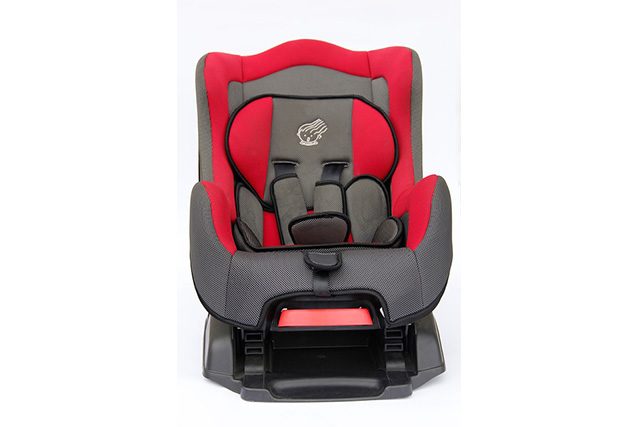A Land Transportation Office executive on Monday suggested the use of bigger cars for their tall children in view of the Republic Act 11229 or Child Safety in Motor Vehicles Act set to be implemented on Tuesday.
In an interview with DZMM Teleradyo on Monday, LTO Director Clarence Guinto discussed the implementation of the new law that requires drivers to secure a child 12 years old and below in a child restraint system (CRCS) when traveling in a private vehicle.
Children are also not allowed on the front seat unless they are properly secured by a CRS or a booster seat.
“This is for the protection of the children, 12 years old and below, kaya we are seeking the cooperation of the public na makiisa dito sa patakarang ito,” Guinto said in the interview.
Guinto said that violators of this law will only be apprehended in “3 to six months” since education and information campaign about the new measure is still ongoing.
Asked if tall children who fall under the age limit should still need to use a booster seat inside cars, Guinto responded:
“Siguro ma’am laki-lakihan mo ang sasakyan mo… We will take note of that.”
Criticisms vs Guinto’s suggestion
This remark of Guinto triggered criticisms from the local online community with several of them questioning its practicality.
A clip of the LTO official’s interview shared by broadcast journalist Jeff Canoy also circulated across social media.
Tyang Amy: Kung ang 12 years old sobrang tangkad at siya po ay lalagyan ng booster…aangat at tatama ang ulo sa kotse. Hindi po ba mas delikado ‘yun?
LTO Director Atty. Clarence Guinto: Siguro Ma’am Amy, laki-lakihan mo sasakyan mo pic.twitter.com/JPQMCVWqNJ
— Jeff Canoy (@jeffcanoy) January 31, 2021
“Di ba this should be based on either the age or the size of the kid? Ayan na naman sila sa mga policies na hindi pinag-iisipan,” a Twitter user commented with an eyeroll emoji.
“Dapat laki-lakihan niya utak niya, galing ng reply dapat sa height limit hindi sa age i-base,” another Facebook user echoed.
“I was 5’7′ by age 12. Can you imagine me–several inches taller than the average Filipino adult–in a booster seat???” a podcast host commented in response to Guinto’s remarks.
“Ok naman ‘yan para sa mga tsikiting pero ‘pag ang bata ay malaki at sayad na ang paa sa floor ng sasakyan at sakto na ang seat belt ay ‘di na kailangan ‘yan. Sino kayang negosyante ang yayaman sa pagbebenta ng product na ‘yan? Baka sa susunod e pati sa single na motor w/ lagyan!” exclaimed another online user.
A Twitter user who described himself as “one of the people who conducted field research” that helped passed the law similarly aired his disappointment over the LTO official’s comments.
“There is a clip of a government official talking about child restraints. Unfortunately, he gave an inappropriate and inaccurate response. While car seats are for kids <12y.o. (below 12 years old), if a child is tall enough, they can just use regular seat belts,” Ado wrote.
What the law and experts say
The RA 11229 states that children who are “at least 150 centimeters or 59 inches in height” or at least 4.92 feet tall do not need to be placed in a booster seat.
Instead, they are supposed to be secured in a regular seat belt.
VERA Files reported that the law was the government’s response to the World Health Organization‘s 2018 report that road crashes were the top killer of people aged five to 29 years old.
The WHO said that in 2016 four in five road-traffic deaths around the world had occurred in middle-income countries like the Philippines.
Lawyer Daphne Marcelo, road safety project manager from public interest law group ImagineLaw, in a January 26 press conference cited that 1,226 children aged 14 and below had lost their lives due to road crashes in 2017.
A CRS or a booster seat is a seat designed specifically to protect children from injury or death during vehicle collisions. It boosts the child for a safer and more comfortable fit of the adult seat belt in cars.
Once the child is big enough to be fitted in the regular car seat belt, then he or she will no longer need to be placed in a booster seat.
The American Academy of Pediatrics‘ Healthy Children website said that those who needed to be placed in booster seats are infants, toddlers, preschoolers and school-aged children.
“Booster seats lift kids up so that seatbelts lie across the strong bones of the chest and pelvis instead of the belly and neck, where they could do serious damage in a crash,” another website, KidsHealth.org, said.
“When children are old enough and large enough for the vehicle seat belt to fit them correctly, they should always use lap and shoulder seat belts for the best protection,” HealthyChildren.org noted.
On Monday afternoon, Guinto issued an apology for his suggestion which he said was made in jest. He also acknowleged that it was “inappropriate.”
“I am sorry for the confusion I have caused with my remark, which was made in jest. I realize now that it was inappropriate,” Guinto said.
“To clarify, if the child is above 4’11, the child is exempted from using a child car seat under the law and may be secured using the regular seat belt,” he added.






